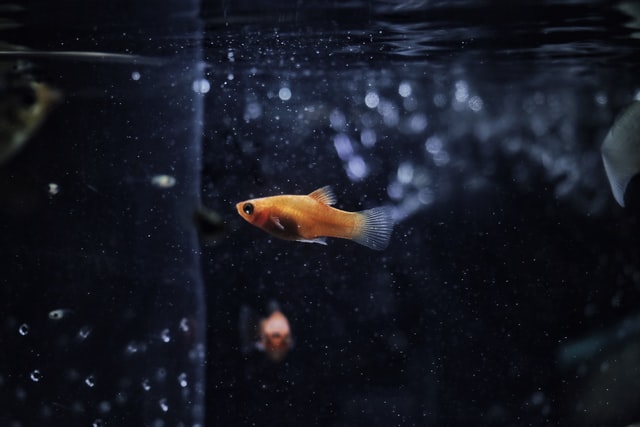Table of Contents
Platy fish are active, colorful and easy to care for. Platy fish is one of the best aquatics to be introduced in an aquarium by new aquarists.
This is because this species of fish is ideal and suitable for a large aquarium. Read on to learn more about providing for their housing, tank mates, feeding, and breeding requirements.
Types of species
The type of species of platy fish found in aquarium today are actually a hybrid of two closely related species:
- Variable Platy Southern
- Platy Swordtail Platy
The Southern Platy shares similarities with the Variable Platy because they are interbred in a way that makes it difficult to distinguish or identify one between the two species.
The southern platy is also called the common platy, and was introduced to the fish tank in the year 1907, on the other hand, the variable platy species was introduced around 1932.
An example of this is the swordtail species of platy, which is also called the spike tail species of platy because of the shape of the fins.
The lifespan of a platy fish
All species do not have a long life span, but could live for about three to five years if given proper care, although they are hardy by their species.
How big are the platies?
They grow to about 5-7 cm in size.
Typical Behavior
Platy fish are small peaceful species of fish. This species are usually very excited when in a small colony or group.
More so, they are happy breeders, and are always active so much that they spend a lot of time swimming in little colonies.
Aggression is not a thing for them although their males outperform females if you do not maintain proper proportions. This species of fish knows how to jump and should be kept in a covered lid.
Habitat and Tank conditions
Southern Platy lives in the beautiful waters that are in Northern Honduras, Guatemala, and Mexico.
Species of variable platy fish come from the waters in Southern Mexico through the Rio Panuco to the Cazones, while the species of Sword tail are found in just Rio Soto La Marina River within Mexico.
The species of Southern Platy and the species of Sword tail dwell in dams, ditches, canals, and springs.
How to cycle a fish tank
The constant excretion of waste by your fish into the water will cause a buildup of decomposing matter at the tank’s bottom. This causes an initial release of ammonia (NH3).
Even at low concentrations, ammonia is highly poisonous. It can accumulate in the tank until the water is so toxic that the fish die.
In an unattended aquarium, the water can become so polluted that the fish will eventually die.
Here, the nitrogen cycle comes into play, as it is a natural process responsible for detoxifying the toxic ammonia and transforming it into a less harmful substance.
Where does this change come from?
Filters and substrates can host bacteria that break down ammonia. Aquariums are home to a wide variety of bacteria.
One variety consumes ammonia and excretes nitrite (NO 2 -1). While nitrite is extremely poisonous, it is quickly converted to nitrate by other bacteria (NO3-).
Due to the low toxicity of nitrate, it can be allowed to accumulate in the water while still being changed out every week.
Platies do not need any particular kind of substrate to thrive. Sometimes they’ll swim all the way down to the bottom, but they won’t actually touch the substrate.
So, gravel or sand, whatever you prefer. In reality, fish couldn’t care less.
Plants and Ornamentation
Plants in the aquarium help create an atmosphere similar to the wild, which is essential for keeping these fish healthy.
Platies love plants. The open swimming areas and plant-filled spaces complement one another beautifully.
Water parameter
They are native to the slightly alkaline and relatively hard tropical waters.
Platies, on the other hand, can thrive in a pH range from 7.0 to 8.0 and an aquarium size of 10 to 20 gallons or more, despite the fact that most livebearers prefer a higher pH.
Tank Mates
Tank Mates Start with a school of three to six platies. To relieve the pressure on the females, it’s best to limit the number of males to every two females. This keeps the ladies from getting worn out from constant chasing.
Can platy fish live on their own?
Yes. They seem to enjoy their own company, but they won’t stick together unless they know you have food.
What other fish species do well in the same aquarium as the platy?
Livebearers like Cory catfish, mollies, snails, bristlenose plecos, rainbowfish, characins, Corydoras, and other platy fish can all coexist peacefully in the same aquarium.
While bettas and platies can coexist peacefully, it is important to provide the betta with plenty of personal space by maintaining a large tank with plenty of plants and decorations.
Incompatible tank mates
You should keep the following species separate from your colony of tank mates for these animals: Fish species include tiger barbs, wolf fish, cichlids, tetras, and tetras.
Put simply, if you have a platy in your aquarium, you should not introduce any aggressive fish.
Diet and feeding
The platy fish in the wild eats a wide variety of foods. They’ll eat just about anything they can get their mouths on, including algae, plants, insects, larvae, fish eggs, fry, and more.
Give them staples like whole fish or shrimp, micro pellets, flakes, and dried foods that are made with nutritious ingredients.
Always make sure your fish are getting the proper nutrition by providing them with a wide range of foods.
How frequently should you feed platys?
Adults only need to eat once per day, but kids should eat two or three smaller meals per day.
How long would a platyfish survive without eating?
Because food is scarce in the wild, animals don’t have to eat every day. Fish can go without food for a week or less if you go on vacation.
However, if you’ll be gone for two weeks or more, it’s probably a good idea to invest in an automatic fish feeder or make other arrangements for the care of your fish.
How do the various platy fish species reproduce?
Platy fish are commonly recognized as live-bearing species because they incubate their eggs within their bodies until it is time to spawn. The resulting fry are typically larger, faster, and have a higher survival rate.
In adulthood, males are a little younger than females. Sexual maturity occurs around four months of age. Direct fertilization of females occurs via gonopodia, also called anal fins.
To my knowledge, fish rarely mate directly with one another, so this is a rare occurrence. They produce clutches of unfertilized eggs, which the males then fertilize.
Male platies are extremely eager to reproduce. It is recommended to always maintain a male to female ratio of one to two. This lessens the likelihood of extreme stress brought on by the male platy fish.
How do the species of platy fishes breed?
The species of platy fish are usually identified as the live bearing fish, and they are known for having their eggs within its bodies till the species are due to birth their fry, that is usually larger, faster, and has a higher survival rate.
Males, slightly younger than women in adulthood. They reach sexual maturity at about four months of age. They have gonopodia – also known as anal fins – where they fertilize women directly.
This is unusual: Most fish do not mate directly. They lay in batches of unfertilized eggs which the males fertilizes at a later date.
Male platies are very keen to reproduce. It is advisable to always keep to have male-to-female ratio of 1 to 2. This reduces the risk of being stressed a lot by the male platy fish.
How do you know when a platy fish is pregnant?
Female platies who are pregnant can be identified by their large bellies and the presence of a pair of black eyes on their bodies.
There are no noteworthy shifts in behavior to keep an eye out for. It’s typical for live-bearing fish to nurse their young until they’re fully grown. The average duration of pregnancy is 28 days. Birthing process A Platy Fry is born ready to swim.
Female platyfish can produce anywhere from 20 to 50 offspring in a month under ideal conditions. Adult platies aren’t protective of their young and will happily devour them if given the chance.
This is why it is important to remove the fry from the aquarium as soon as possible. To achieve this, you should monitor the aquarium for at least two hours to identify if any fry has been born.
Make sure to look under the rocks, they are quite smaller (quarter-inch long or less) than the adult platies.
After Care Adults do not show parental care for their children and may eat their own food, therefore, we recommend using a breeding tank of about 10-20 liters per filter.
Prepare a separate tank for the fry, let the water matches the conditions of the water in which they were born.
Use a plastic scoop or net to gently remove the fry and place them in a separate tank. Keep them here until they are about the same size as their parents, and bring them back.
Care For Platy Fish
Species of platies are usually little fishes that are not necessarily open to illness or aquatic diseases specifically, they are quite strong although they are usually prone to fin rot and ich.
More so, diseases of the fish are not very easy to identify, depending on the level in which it is spotted, and it may not be easily treated.
The ich is a parasitic disease that leaves white spots all over the gills, fins, and the body of the fish. It is one of the most common diseases in the aquatic habitat, if left untreated, this often leads to damages and infections to the respiratory system of the fish.
However, a lot of treatments from raising the water temperature to the use of medications can be used to treat ich.
In addition to that, it is always best to prevent the diseases from happening at all by ensuring that the quality of the water is good and that they feed right.
More so, to promote a good environment, it is important to reduce the rate of stress that fish will undergo.
Summary
The platy species are typically calm and colorful, which makes them perfect for many aquatic environments.
The setup or tank you use to store them doesn’t have to be big. If you’re just starting out, I’d recommend them. They’re the perfect size to be kept in a tank with any other peaceful little fish. Maintaining a platy tank is never boring.







